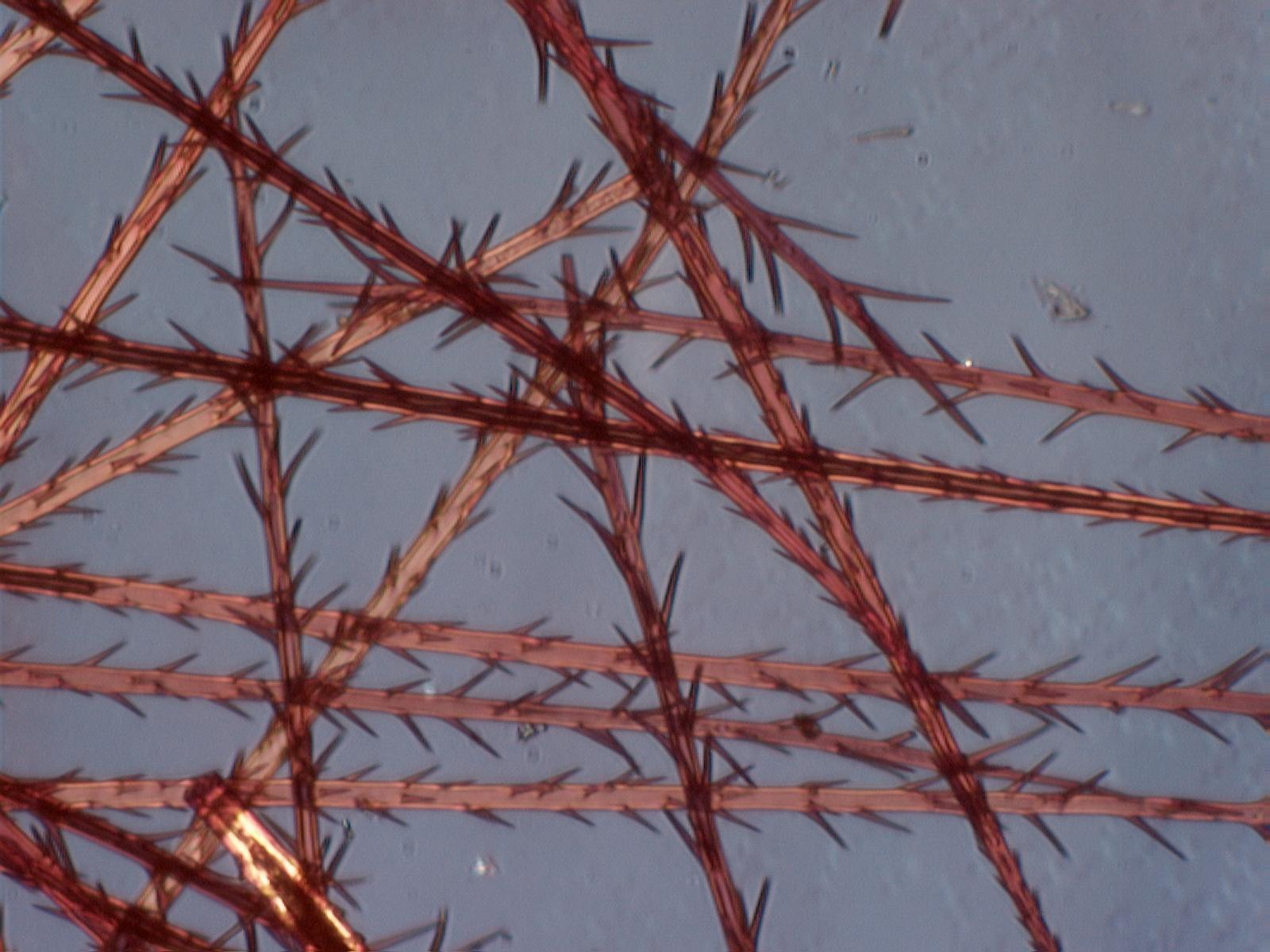Tent Caterpiller Hair
Transmitted Off Crossed Circular Polarized Light
Maier, H., W. Spiegel, T. Kinaciyan, H. Krehan, A. Cabaj, A. Schopf, and H. Honigsmann, "The oak processionary caterpillar as the cause of an epidemic airborne disease: survey and analysis", British Journal of Dermatology, vol. 149, no. 5, pp990-997, 2003.
Hossler, E. W., Catepillars and moths:Part I. Dermatologic manifestations of encounters with Lepidoptera", Journal of the American Acadamy of Dermatology, vol. 62, no. 1, pp. 1-10, January, 2010.
Hossler, E. W., Catepillars and moths:Part II. Dermatologic manifestations of encounters with Lepidoptera", Journal of the American Acadamy of Dermatology, vol. 62, no. 1, pp. 13-28, January, 2010.
Definition/Function:
Insect "hair" is not like mammalian hair. It is refered to as hair because of its similar appearance on the insects body. Techincally they are more properly called seta (pl. setae). Chemically it is Chitin rather than Keratin. Keratin is a protein that contains sulfur and will react with sodium azide solution while chitin is a nitrogen containing polysaccharide.Significance in the Environment:
Some individuals are alergic to insect debris, including body fragments and hair. Some hairs are stiff enough to be an irritant of mucosal tissue and the skin. Some insect fragments and hair contain compounds that are chemical active in the human body.
In the case of the hairs from catepillars and moths, they may actually carry a toxin. The reaction to the hair of some of these species can be quite serious (see references below).
Characteristic Features:
The setae and the rest of the exoskeleton are basically the nitrogen containing polysaccharide chitin. Chitin is oriented in such a way that the exoskeleton fragments show little birefringence. The setae on the other hand may be quite birefringent. The birefringence in the setae is highly variable and becomes a distinguishing feature, in some cases identifying species and in others identifying genera. The birefringence of insect setae is never as high as in the cellulose plant hairs or some of the chitin setae of mites, but it is higher than in the exoskeleton fragments.Associated Particles:
References:
Balit, Corrine R., Helen C Ptolemy, Merilyn J. Geary, Richard C. Russell, and Geoffry K. Isbister, "Outbreak of caterpillar dermatitis caused by airborne hairs of the mistletoe browntail moth (Euproctis edwardsi), MJA, vol. 175, pp. 641-643, 2001.Maier, H., W. Spiegel, T. Kinaciyan, H. Krehan, A. Cabaj, A. Schopf, and H. Honigsmann, "The oak processionary caterpillar as the cause of an epidemic airborne disease: survey and analysis", British Journal of Dermatology, vol. 149, no. 5, pp990-997, 2003.
Hossler, E. W., Catepillars and moths:Part I. Dermatologic manifestations of encounters with Lepidoptera", Journal of the American Acadamy of Dermatology, vol. 62, no. 1, pp. 1-10, January, 2010.
Hossler, E. W., Catepillars and moths:Part II. Dermatologic manifestations of encounters with Lepidoptera", Journal of the American Acadamy of Dermatology, vol. 62, no. 1, pp. 13-28, January, 2010.


